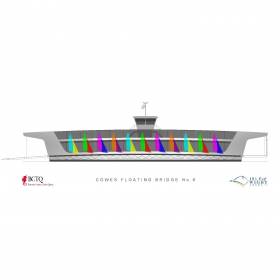Displaying items by tag: New 'Floating Bridge'
Sailing Mecca of Cowes To Get New ‘Floating Bridge’
#FloatingBridge – A replacement for the Isle of Wight’s Cowes-East Cowes Chain ferry known affectionately as the ‘floating bridge’ is to be introduced next year at the famous sailing venue, writes Jehan Ashmore.
The busy crossing on the River Media, is one of the few remaining in the UK that has not been replaced by a physical bridge and the 37m newbuild to be built in Wales. The newbuild will form the sixth generation ‘floating bridge’ since the service began in 1859.
The contract for the chain-ferry has been awarded to Pembrokeshire based boat-builder, Mainstay Marine Solutions Ltd. The order at the Pembroke Dock yard will create another 20 jobs bringing the workforce up to 100.
The newbuild to a design by Burness Corlett Three Quays (BCTQ), incorporates an upper and lower deck for passengers to access during the crossing and features panoramic windows to optimise light and viewing of the scenic river and harbour setting.
Currently, the 18 hours a day operation which only takes 2.5 minutes to complete is operated by No. 5 Cowes Floating Bridge, which has been in service for the last four decades. The frequency of every 10–15 minutes allows to transports around 1.5 million pedestrians and 400,000 vehicles annually.
The newbuild will have even greater generating capacity given additional space for foot passenger and vehicles to board at the same time and help reduce on loading times.
The Cowes service has been owned and operated by the Island’s local authority since 1901 and more than a hundred years later this latest floating bridge is to be funded by the Isle of Wight Council and the Solent Local Enterprise Partnership as part of the East Cowes Regeneration Project.
The drive through, roll-on roll-off chain ferry with hydraulically operated loading and unloading ramps at each end of the vessel. The deck will have 4 lanes for vehicles with additional space for the stowage of motorbikes, scooters and bicycles.
Designed in accordance with the BV’s classification of Inland Navigation Vessels, the 37m long vessel will be capable of reaching up to 5 knots and will carry a total deadweight of no less than 52.65 tonnes.
The project is due for completion at the end of the year with trails and commissioning at Cowes in January 2017.





























































